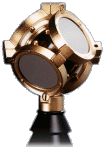In the beginning was sound. Then some beings from earth began attempting to record and reproduce it. A number of devices appeared in late of 1800, but phonograph or gramophone became the most known recording and reproducing devices from 1920 until the end of World War II [1].
Until late ’50s those devices offered to consumers a monophonic image of recorded sound. Mono reproduction means that the only space aspects that are perceived from a listener are distance and depth. For mono reproduction one loudspeaker is required, but signal can also be reproduced from multiple loudspeakers into a single transmission path. The first multitrack (four tracks) recording that was mixed both in mono and stereo versions was the Beatles’ Album ‘Sergeant Pepper’ in mid ’60s, after the availability of stereo sound systems to public. The popularity of stereo reproduction increased quickly after then. Stereo reproduction requires two loudspeakers, as audio signal has two or more independent channels. Listeners perceive differences in position, depth, distance, as well phantom images of the separate sound sources [2].
Experiments for surround sound were conducted from 1930, but the first surround technology appeared through a Walt Disney’s animation, ‘Fantasia’ in 1940. Disney created first the Fantasound technology: a surround sound field with left front, center front, right front, left rear, and right rear channels [3]. Surround audio systems failed to be accepted into consumers’ homes and theatres those times because of their high cost and their complexity. Many albums of Beatles, Ringo Starr and other artists were sold in a 5.1 or quadraphonic (4 channels) format during the decade of late 60s – 70s but listeners’ support was very little [4]. The release and success of film ‘Star Wars’ in 1977’s, was the reason that most of theatres began to be upgraded and to acquire surround sound format Dolby Stereo (four-channel technology), which was introduced by Dolby Laboratories in 1976. Stereo Surround Sound System started evolving since then, offering less noise, clearer playback, wider dynamic range and broader frequency response than previous systems [4]. Dolby Digital Surround, where sound information is no longer analogue, but digital, was introduced only in 1992. It is then when 5.1 known configuration of surround (left front, centre front, right front, left surround, right surround, and a low frequency effects channel) started entering powerfully into our lives [5].
The reproduction of a 3D dimensional soundscape appeared around 1975 with binaural recording and reproduction, where audio signals comprise amplitude and time elements similar to human ears’ features. These recordings, where two omni microphones are located in the ears of a dummy or a real human head, are not compatible with loudspeakers. Conclusively, binaural tracks can only be listened on headphones (unless the signal is to be processed). This technique is utilised nowadays by virtual reality systems and games environments [5].
Human exploratory spirit would not stop there. Since science and technology offers to us so many implements, we want to reach the best, and why not, even perfection. And here comes a system that has been created to approach real sound environment about human’s audio perception. Ambisonics started developing in ’70s by Michael Gerzon, Peter Fellget and other audio engineers. Their intention was to recreate a full three dimensional sound field, which means that sound reproduction would have to be 3D, as it includes W, X, Y and Z axis. Of course the more loudspeakers are utilised, the more realistic becomes the sound environment. As it is not possible to set up loudspeakers all over listener, he/she must be affected by some key principles of psychoacoustics to perceive 3D sound [6]. Soundfield microphone released in February 1975, and it comprises four tiny microphones in one. It is widely utilised since then, because of its range of polar patterns and directivity points without the need to move it, as well because it can act as a stereo microphone. In contrary, ambisonic system did not succeed commercially and it is still rarely utilised for recording and reproducing processes [5].
An Ambisonic application was introduced lately in the first Hellenic Patent Exhibition in Athens. It is the 3D Sound Sphere that was generated by two young Greek people, Pavlos Tripodakis and Giorgios Konstantinidis, both of them graduates of Music Technology and Acoustics Department of Technological Educational Institute of Crete. In 3DSS listeners are able to enter into a globe surrounded symmetrically by ten loudspeakers and two subwoofers. The result is listeners to experience a total 3D audio reality!
More information and material upon this application are given to this post and this one.
[1] Morton, D. ‘The History of Recording Technology’, on Recording History website < http://www.recording-history.org/index.php> [accessed 28/11/2010]
[2] ‘Mono vs Stereo’, on Diffen website <http://www.informit.com/articles/article.aspx?p=337317> [accessed 28/11/2010]
[3] Silva, R. ‘Surround Sound – What You Need to Know -The History and Basics of Surround Sound’, on About.com: Home Theatre website <http://hometheater.about.com/od/beforeyoubuy/a/surroundsound.htm> [accessed 28/11/2010]
[4] Miller, M. (2004), ‘The History of surround sound’, on InformIt webpage <http://www.informit.com/articles/article.aspx?p=337317> [accessed 29/11/2010]
[5] Rumsey, F. (2001), ‘Spatial Audio’, Oxford, Focal Press
[6] Thornton, S. (2009), ‘Ambisonics’, on michaelgerzonphotos.org.uk website <http://www.michaelgerzonphotos.org.uk/ambisonics.html> [accessed 29/11/2010]





This is a fantastic blog! I loved the way you introduced the topic, almost biblical in its charm!
I have a personal interest in 5.1 and 3D sound and some time ago I did a research about this and your work here helped me to remember many things as well as to discover a lot of new things that enriched my understanding of this technology and it’s historic background.
I find the 3D sphere concept and application simply amazing and every sound engineer or acoustician’s dream, really.
Keep it up with the blogs, they are excellent!
Hi Adan! Thanks for your wonderful words, it was very interesting to me also the process of research upon the sound reproduction systems’ history!
I am very impressed with your researches and the scientific aspects of the subject!
Thank you!